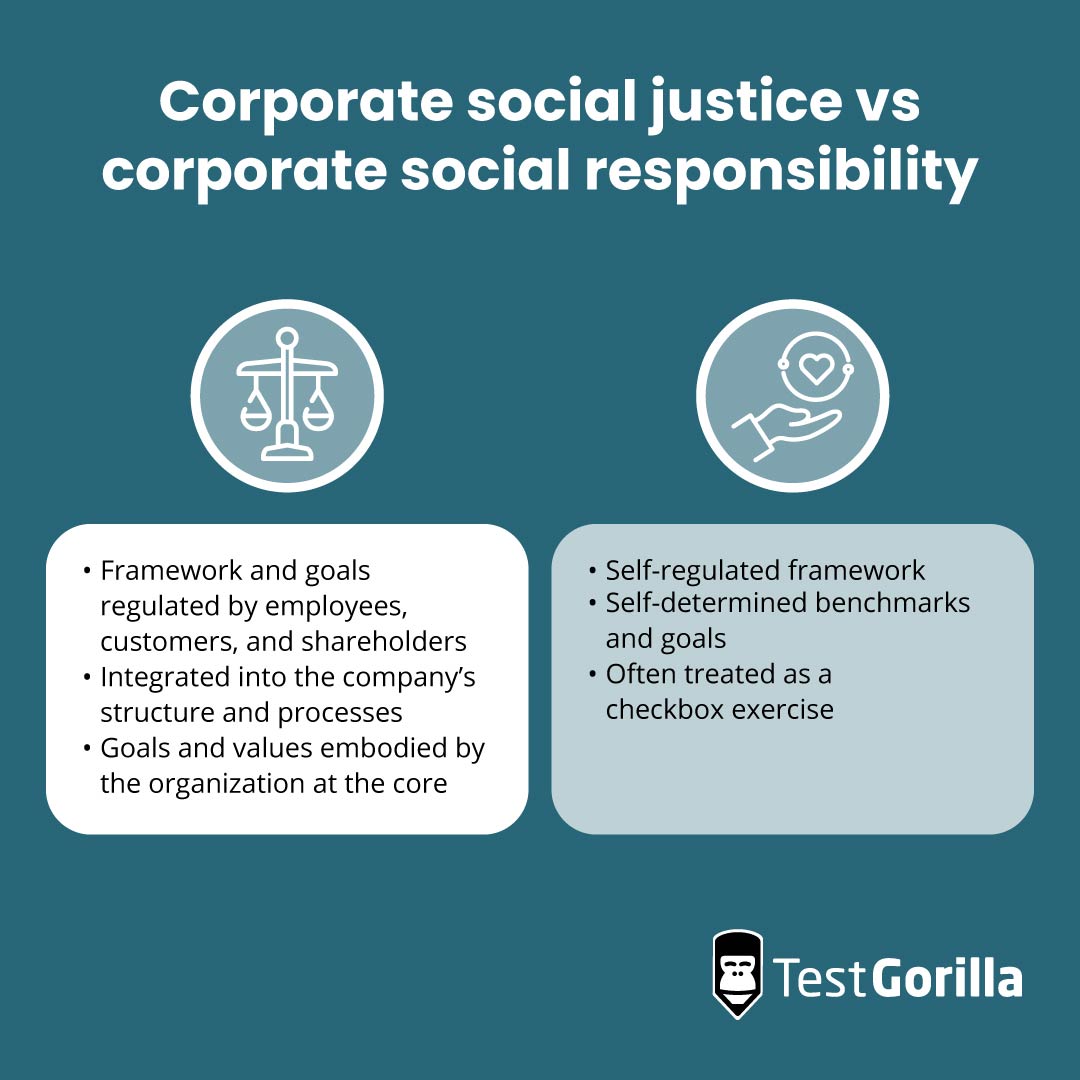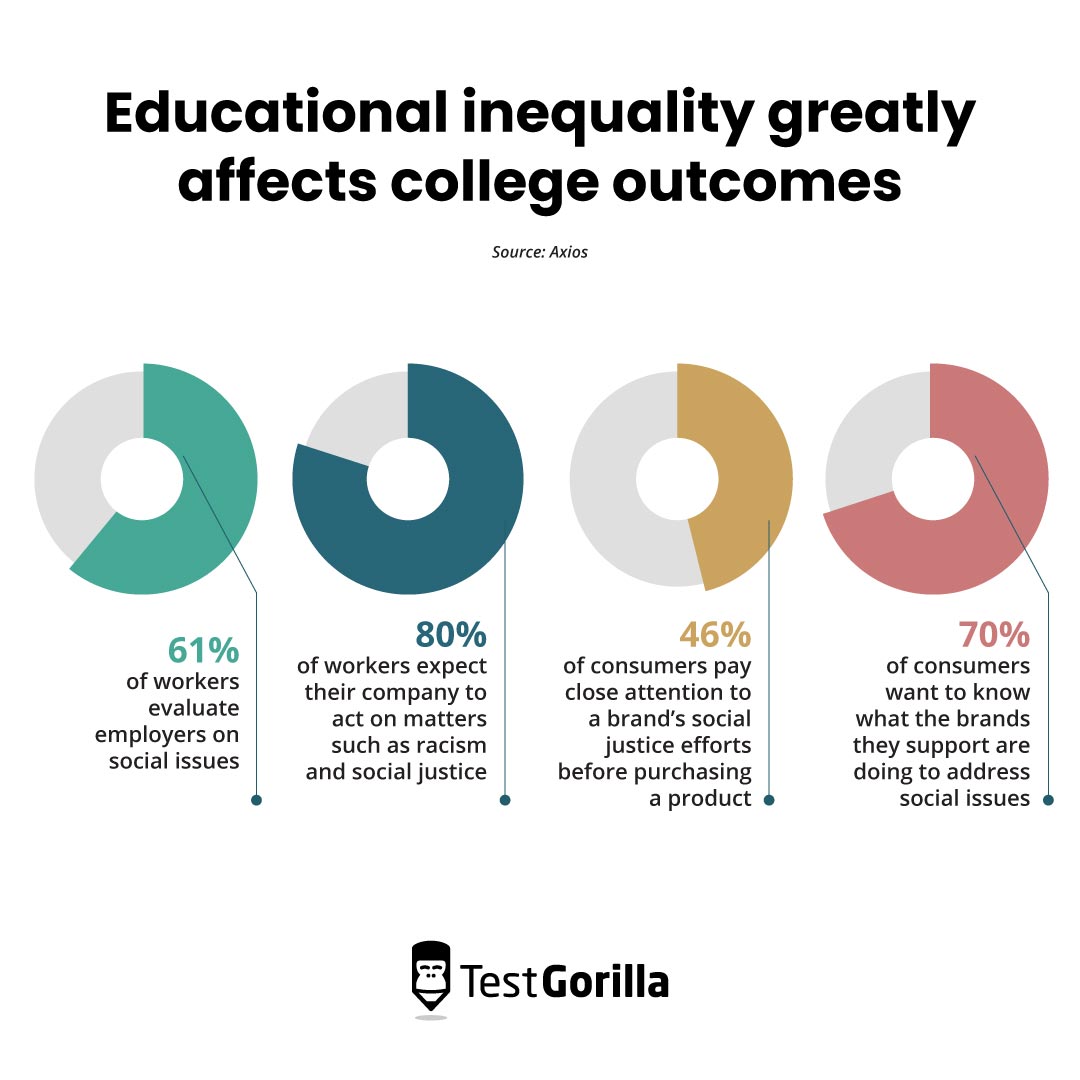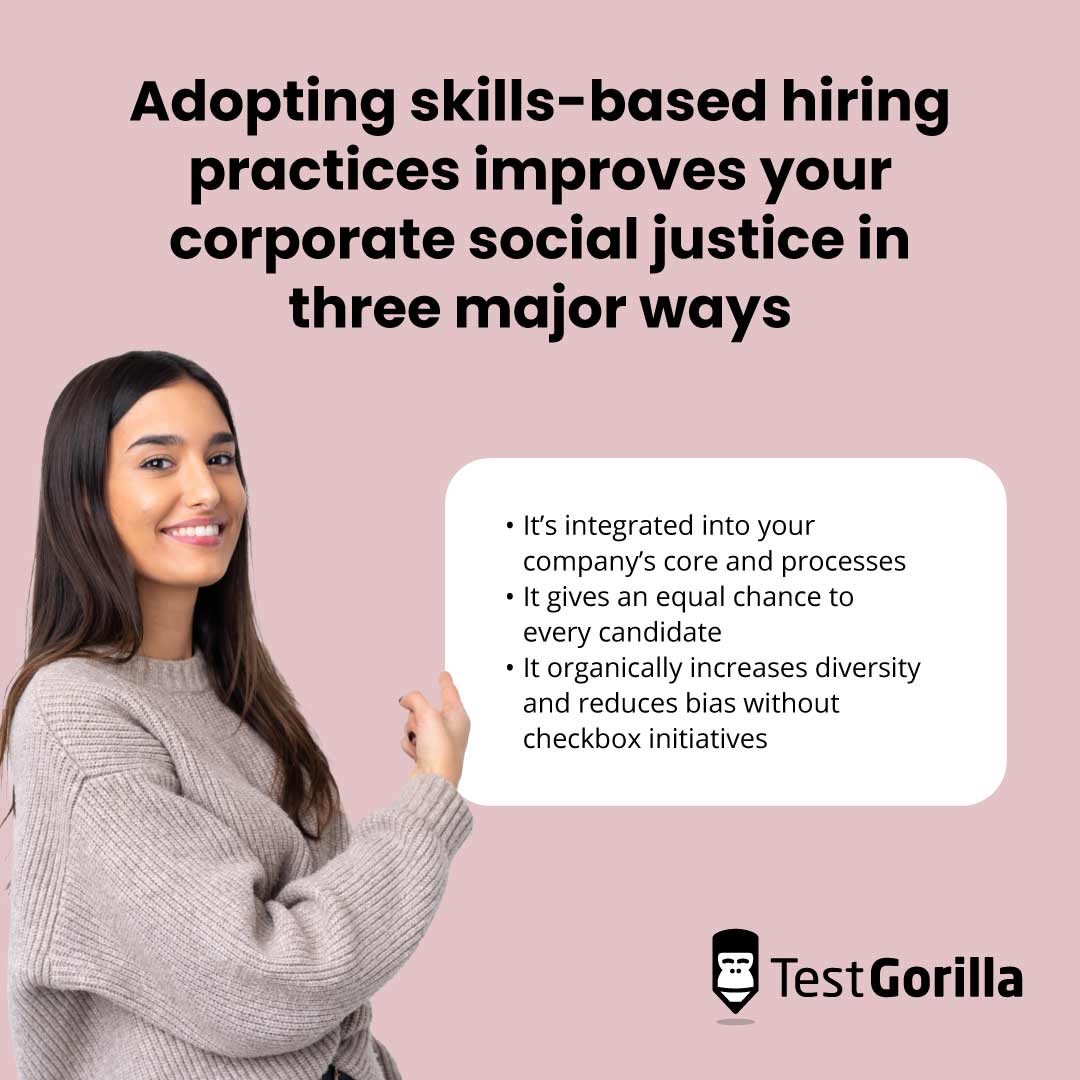Why corporate social justice should be a cornerstone of your hiring process
Corporate social justice is an essential element in every business strategy.
When a company takes a firm stance on social issues and shows real action on improving them, it usually involves giving a fair chance to disadvantaged groups.
Corporate social justice can be woven into much of your organization, but the hiring process, as the place where all employees start, should take special attention.
Many traditional hiring methods have the opportunity to hold unconscious biases and can lead to unfair hiring, naturally preventing you from enforcing social justice.
When you refine the hiring process with skills-based hiring practices, like using skills tests and conducting structured interviews, you can hire the best candidate for the role regardless of their race, gender, ethnicity, age, or sexual orientation.
This article discusses how skills-based hiring makes positive changes to the hiring process by improving corporate social justice and helping companies take a stand for fairness and equality.
Table of contents
- What is corporate social justice?
- Why should corporate social justice be a part of your hiring process?
- How do you integrate corporate social justice into your hiring process?
- How skills-based hiring assists your corporate social justice strategy
- Use skills-based hiring to promote corporate social justice and embody your values
- Source
What is corporate social justice?
Corporate social justice goes beyond simple charity work and promises for a better tomorrow. It’s about taking tangible action on powerful issues, usually involving disadvantaged or marginalized groups.
You may have heard the term “corporate social responsibility,” but this is not the same. How is corporate social justice different from corporate social responsibility?
Too often, corporate social responsibility is a “tacked-on” process that doesn’t have full leadership support, isn’t embodied by the whole company, and doesn’t make an impactful difference.
Leadership needs to fully support these efforts and weave them into the fabric of the organization. We go into this in-depth in our article on the changing roles of managers in a skills-first organization.
Essentially, corporate social responsibility doesn’t have any social or legal obligation to stakeholders to make meaningful change and is often considered a “background” effort.
Let’s take a look at a direct comparison:
Corporate social responsibility: AT&T won a perfect score on the Human Rights Campaign’s Corporate Equality Index in 2017, but was heavily criticized for donating more than $2.5m to anti-gay politicians the same year.
Corporate social justice: The Chicago Community Trust set a goal to close the wealth gap between Black, White, and Latin American households in Chicago, a goal they embody wholly as a company that directly affects their customers and stakeholders.
The goal that the Chicago Community Trust set appears to mean something to their organization, their community, and their stakeholders.
Companies that embody corporate social justice are addressing injustice and fighting for equality by actively molding the future.
Corporate social justice isn’t a separate initiative treated like a checkbox exercise. Often, corporate social responsibility is linked to diversity and inclusion targets, which, while common, can be problematic.
These targets don’t always promote diversity, equity, and inclusion efforts, and if done wrong, can even harm inclusivity and diversity. For more insights and information on how you can promote diversity in a healthy way, read our article on diversity and inclusion targets.
Here’s a comparison table to summarize the differences between corporate social justice and corporate social responsibility:
Corporate social justice | Corporate social responsibility |
Framework and goals regulated by employees, customers, and shareholders. | Self-regulated framework. |
Integrated into the company’s structure and processes. | Self-determined benchmarks and goals. |
Goals and values embodied by the organization at the core. | Often treated as a checkbox exercise |
Why should corporate social justice be a part of your hiring process?
Corporate social responsibility is no longer enough for customers, employees, and stakeholders.
Protests about inequity and injustice have been shaking the world, and many of them are about unfair hiring, unequal pay, and unequal social rights.
Although workplace discrimination like this is illegal, it can still impact companies in two ways:
It could be happening behind the scenes
It could be happening due to unconscious bias
Yes, unfortunately, a lot of unequal treatment happens due to unconscious bias, which means we aren’t even aware of the unfair acts being conducted.
For more information on this topic, read our blog on disparate impact practices and disparate treatment.
In this age, companies need to take a stance and stand by it. Your people need to see you take meaningful action.
Every company has a wide range of stakeholders whose satisfaction must be balanced with the company’s financial performance.
But corporate social justice and an organization’s financial performance aren’t necessarily at odds, so one can work toward the other.
For example, corporate social justice helps support your hiring efforts and brings more top talent in.
The Great Reshuffle caused countless workers to shuffle from their companies and look for an accepting, equal workplace.
One study found that 61% of workers evaluate employers on social issues, and about 80% expect their company to act on matters such as racism and social justice.
Further, a separate study found that 46% of consumers pay close attention to a brand’s social justice efforts before purchasing a product. And 70% of consumers want to know what the brands they support are doing to address social issues.
Of course, the main reason to integrate corporate social justice into your organization is that it’s simply the right thing to do.
Lily Zheng, a diversity, equity, and inclusion strategist and consultant, spoke on this topic in a recent post. They describe having a conversation with a man on a plane about DE&I.
After inquiring about what exactly DE&I is, they said the man eventually concluded with their help that DE&I is simply “common sense.”
Hiring managers and HR professionals should be at the forefront of removing biases and unfair practices from the working world. They can’t rely on the system to sort itself out.
In reality, HR professionals and recruiters are the system that needs to make a positive change. They must sort out themselves and their own practices. This gives you the power and responsibility to make a meaningful impact.
Taking action within your own organization is the first step to eliminating unfair practices and creating a better, more equitable future for your company and industry.
How do you embody these inclusive goals and turn your corporate social responsibility into action-oriented corporate social justice?
Adopt skills-based hiring practices where you involve real people in your social objectives, like stakeholders, employees, and candidates.
Your hiring process is how new employees enter your organization, which means it shapes how your company runs and how your culture unfolds.
It’s a powerful way to make a lasting difference that affects the core of your organization.
The best insights on HR and recruitment, delivered to your inbox.
Biweekly updates. No spam. Unsubscribe any time.
How do you integrate corporate social justice into your hiring process?
A great start is by adopting skills-based hiring practices to achieve fairer hiring practices, better business outcomes, and a more diverse team.
According to TestGorilla’s State of Skills-Based Hiring report, 80% of companies had a goal of increasing diversity in 2022, and more than 90% of organizations that used skills-based hiring saw an increase in diversity.
Adopting skills-based hiring practices improves your corporate social justice in three major ways:
It’s integrated into your company’s core and processes
It gives an equal chance to every candidate
It organically increases diversity and reduces bias without checkbox initiatives
Using skills-based hiring practices ensures that these diversity-minded values are deeply integrated into your organization.
Diversity and inclusion targets, such as “acquire 25% more ethnic minority trainees,” although well-intentioned, simply choose a number and start hiring specifically for it.
Skills-based hiring recruits whoever is best for the role, regardless of race, gender, or age.
This means that skills-based hiring also reduces bias and gives an equal chance to all disadvantaged demographics, including groups that are traditionally left out of diversity initiatives, like neurodivergent people and older workers.
DE&I initiatives and corporate social responsibility are rarely aimed at these marginalized groups.
This is unfortunate when the ASD employment gap is one of the largest current employment gaps: A UK study found that only 29% of autistic adults are employed. Traditional hiring methods are only perpetuating and worsening it.
These other demographics are important to recognize because having true diversity and justice means focusing on diversity in all its forms.
An example of skills-based hiring as a part of a corporate social justice strategy is the furniture company Steelcase.
Steelcase’s recruitment process prioritizes skills more than resumes, removes experience requirements wherever possible, and promotes learning and development more than perfection.
Because of these practices, in 2021, 76% of their US interns were Asian, Black, Hispanic, or women in STEM.
Steelcase said this about their skills-based practices and the impact they have on diversity:
“For over a century, we’ve used our core values to guide corporate decision-making and shape our culture – and that starts by treating people with dignity and respect.”
To read more stories like Steelcase’s, check out our article on skills-based success stories.
How skills-based hiring assists your corporate social justice strategy
It’s all well and good to say that skills-based hiring helps achieve your corporate social justice goals, but we’re going to explain how this hiring strategy can promote fairness and give an equal opportunity to all candidates.
Here’s a quick summary:
Reduces bias to hire the ideal candidate
Assesses “culture add” over “culture fit”
Emphasizes upskilling and development
1. Reduces bias to hire the ideal candidate
Skills-based hiring prioritizes skills and capabilities when assessing a candidate. This means it values skills over degree, work history, and experience.
It also has little reliance on resumes, which are not only unreliable at best for verifying skill, but also leave a chance for gender, class, and racial biases.[1]
We recommend getting rid of the resume completely. With today’s technology, we have ways to assess skills without ever involving a resume and the potential for bias they hold.
It’s important to remember that biases like these happen without your conscious knowledge. Even the most equal-minded people have the chance to be affected by unconscious bias.
We hear your question: Do I need to adopt skills-based hiring to reduce bias when my organization holds DE&I training?
DE&I training is a positive step for companies to take, but it isn’t as effective as skills-based hiring when it comes to avoiding bias.
For example, a survey in 2019 after the #MeToo backlash found that:
19% of men were less willing to hire women perceived as attractive
21% were less willing to hire women for jobs involving close interpersonal interactions
27% now avoided one-on-one meetings with female colleagues
Ultimately, the lessons that were learned caused an overcorrection that perpetuated the bias rather than reducing it. Corporate social justice awareness and training should promote diversity, but it doesn’t always.
Skills-based hiring and skills tests evaluate candidates, bypassing human bias and hiring the best candidate, whether they’re female, Black, Hispanic, LGBTQ+, or anything else.
2. Assesses “culture add” over “culture fit”
For years, “culture fit” has been a hiring staple that companies have used to find like-minded employees.
However, it holds a huge chance for bias, keeps great opportunities from diverse individuals, and is a barrier holding your corporate social justice strategy back.
In fact, a 2021 study found that only 15% of hiring managers across seven countries believed that workers over 45 applying for an entry-level position were a “fit.”
When a candidate needs to “fit” into a company and the current workforce, it narrows the pool considerably. Almost 90% of Fortune 500 CEOs are white males, making the standard “culture fit” confining in terms of race and gender.
Culture fit is on its way out. “Culture add” is on its way in.
What’s culture add? Hiring for culture add means building a healthy culture of people with similar values and goals, rather than requiring that candidates “fit in” to a rigid culture.
Culture add is an important part of skills-based hiring and another way that skills-based hiring promotes equity and fairness.
This practice also helps you spread your corporate social justice strategy and hire people that further your mission.
Evaluating candidates with culture tests helps you nurture and build a company culture based on compassion, equality, and empathy. It enables you to use your core values and mission and hire specifically for it.
3. An emphasis on upskilling and development
Learning and development are a huge part of promoting corporate social justice.
Professional growth is important to all employees, so why is it specifically imperative for corporate social justice strategies?
When your company prioritizes learning and stops trying to hire an employee that’s perfect from day one, it opens the talent pool for thousands of disadvantaged candidates.
This is crucial for your corporate social justice strategy when so many marginalized candidates don’t possess a bachelor’s degree.
According to one study, four-year degree requirements automatically screen out 83% of Hispanic and 76% of Black candidates.
But when upskilling is a core value in your company, anyone can advance and grow into a role – they don’t need 100% of the requirements.
For example, Sam Saucedo-Hernandez found a solid job as a medical administrative assistant because of a job training program willing to teach her the skills she needed to succeed.
Healthcare administration is an industry that’s challenging to get into. It can take someone six to eight years of difficult work to receive the required degree.
Thanks to learning and development opportunities, Sam was able to find a reliable job and support her children.
Upskilling and reskilling are cornerstones of skills-based hiring that help hiring managers find great nontraditional talent and enable employees to advance and grow in their current roles.
Use skills-based hiring to promote corporate social justice and embody your values
The modern world demands that companies take an active approach to social issues, and we couldn’t agree more.
Corporate social justice is about rallying behind equality in all its forms, and for organizations, it starts with your hiring processes.
Adopting skills-based hiring is an excellent way for your company to promote fairness from its core: reducing bias, nurturing an inclusive culture, and emphasizing continuous improvement.
Now, that’s much more than a checkbox exercise.
If you’d like to start learning the steps to adopting skills-based practices, read our blog on the 7 barriers to implementing skills-based hiring.
To assess your next candidate’s knowledge of ethical issues and anti-discriminatory policies, take a look at our Business and Ethics Compliance test.
Source
Rivera, Lauren; Tilcsik, András. (December 21, 2016). “Research: How Subtle Class Cues Can Backfire on Your Resume”. Harvard Business Review. Retrieved April 11, 2023. https://hbr.org/2016/12/research-how-subtle-class-cues-can-backfire-on-your-resume
You've scrolled this far
Why not try TestGorilla for free, and see what happens when you put skills first.

















